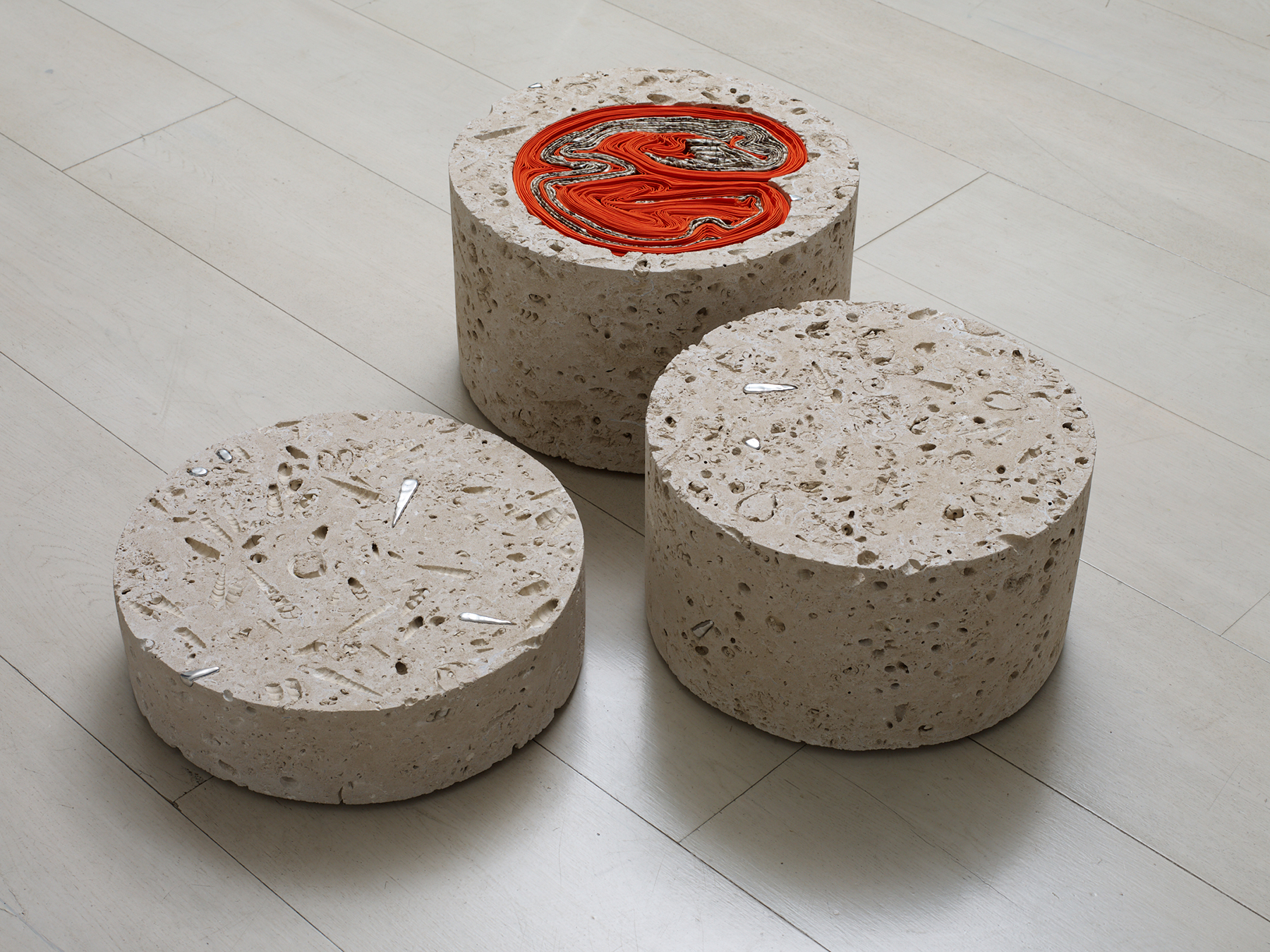


Alice Channer’s new exhibition Megaflora shows sculptures that revel in the complexities and processes of the natural world, contrasting it with industrial production. Brambles as thick as tree trunks, crystallised living organisms, majestic plants, bacteria and shells. These are the protagonists of this exhibition conceived during lockdown, as we all followed the natural world more closely.
In the middle of the gallery space sits three cylindrical sculptures. Made from Portland stone, their surfaces are pockmarked with the fossils of hundreds of ancient sea creatures. Shining aluminium has been cast into them, fixed within the material. The presence of red fabric tightly folded to fit within one of the stones adds another element of material captivity, whilst setting the work in the present. The sculpture is called Biolith, “a sediment formed by the remains of living organisms”. The shells and stone are as one, entangled over millions of years, whilst also relating to the synthetic and industrial processes that created the hot red fabric.
Biolith introduces the works in the exhibition that holds together so many different materials, natural and man-made, all pulled tightly together. “My work is very much about the present”, stated Channer in a recent interview. Walking around the exhibition one feels that all the works demand us to be present: to enjoy them, to acknowledge the complexity of their making and existence, and thus consider the complexity of our own existence.
Channer’s sculptural practice is about the process of transforming materials. The works are set in tense dialogue with one another: from outside the gallery the red print Moult introduces Biolith, and from there the eye moves to another floor-based sculpture, where the ammonite shells are placed on a tool bar that inserts objects into a chroming machine.
Then, the eye moves to the wall, upon which hang delicate shells coated in aluminium. It is from here one glimpses the work that gives this show its title. Megaflora stands alone in its monumentality. A giant bramble, scanned, enlarged and coated with aluminium, it still bears the marks of its making. The exaggerated scale is intimidating, the enlarged thorns like threats in space.
The process that dramatically transforms the humble bramble is both forceful and violent, yet Megaflora is also an inviting sculpture. It remains hollow within, a sensual invitation to look closer, as if seeing something we desire. Bramble yet tree, industrially made yet sensually built, the process has transformed the future life of this humble thorn.
Layering, combining, mutating, mixing, scaling. These seem to be actions performed in Channer’s process. At the back of the gallery stands another visual highlight. Two sumptuous acid green pieces hang on the wall. Just like Megaflora they have undergone a process of transformation. A lush green photograph of a leaf is printed, pleated, then attached to an underlayer of coral fabric. Horizontal Empress Wu, named after a powerful Chinese Empress from the 7th Century, refers to the image used: a spectacular giant Hosta named after her and characterised by bright green velvety leaves.
The careful punctuating of the works inside the space and the various ways in which they embody their techniques and materials creates a filtered, clear environment that demands attention as antithesis to nostalgic thoughts and feelings. Like the fabric trapped inside the Portland stone, it makes us reflect on the complexities of our times.
Ilaria Puri Purini
Curator of Programmes
Large Glass, 392 Caledonian Road, London N1 1DN. Open by appointment Wednesday-Saturday 11.00-18.00. Exhibition continues until 26 June 2021. www.largeglass.co.uk